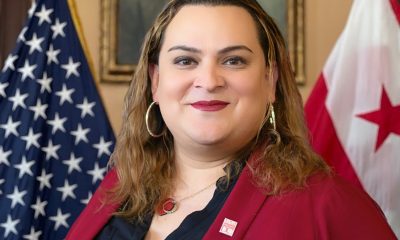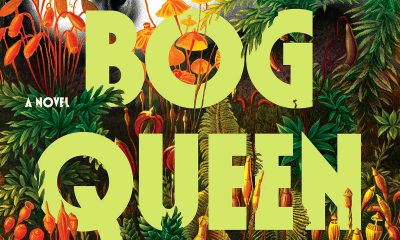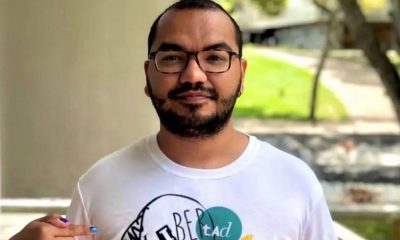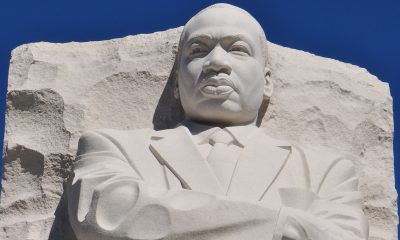Books
Graphic novel ‘Smahtguy’ offers timely bio of Barney Frank
Cartoonist Eric Orner makes policy suspenseful
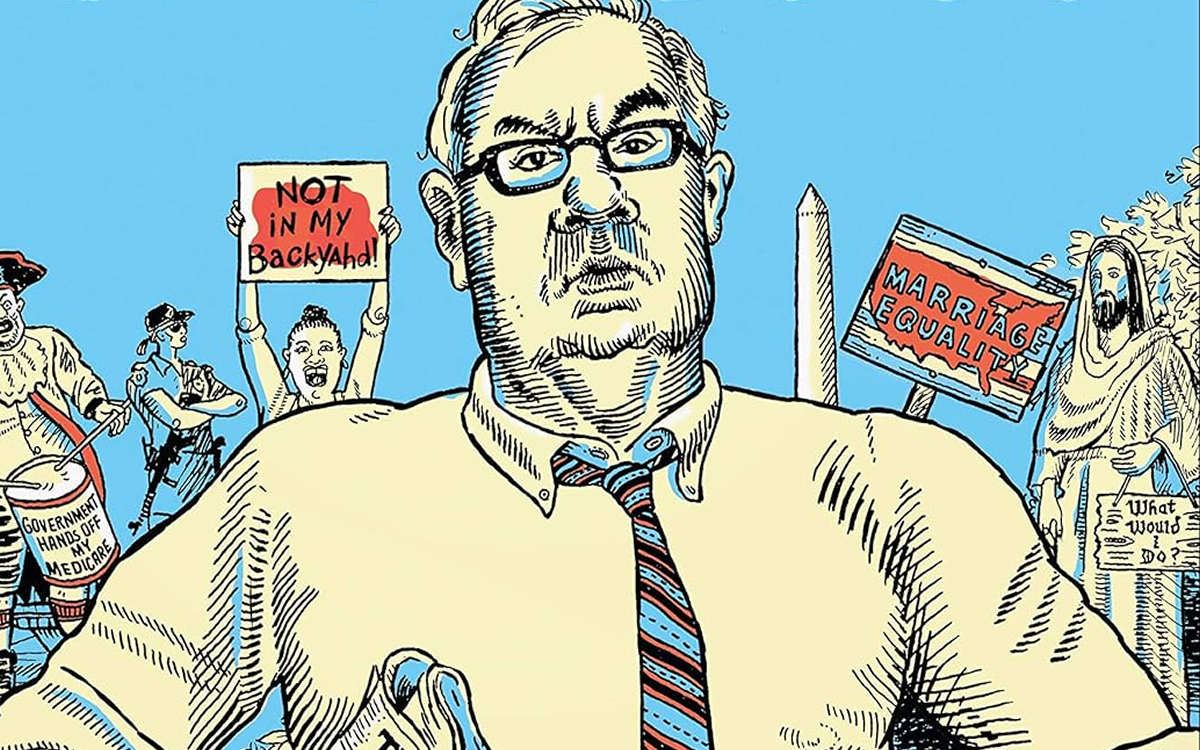
When he was in high school, gay cartoonist Eric Orner, who makes his graphic novel debut with “Smahtguy: The Life and Times of Barney Frank,” didn’t like the food in the school cafeteria. “The principal was always talking about how good we had it,” Orner told the Blade in a recent interview.

“But the food was deep fried – inedible,” Orner added, “even for us [teens].”
To protest the food, Orner called it out with humor in the comic strip he drew for the school newspaper. “Having this platform to express yourself subversively and sarcastically to authority,” Orner said, “gave me a buzz.”
Like a hound born to hunt, Orner has always loved to draw. A proclivity for subverting the powers that be with humor has been etched in his veins from birth.
“Drawing is what I love to do,” said Orner, who is in his 50s, “It’s been that way since I was a kid.”
If there’s a problem, Orner will sit for an hour and draw. “I’ve been most brave – most outspoken when I’m drawing.”
Orner’s drawing and respect for outspokenness are in splendid form in his graphic novel “Smahtguy,” a biography of queer icon Barney Frank.
As the House (at this writing), repeatedly fails to elect a Speaker, nothing could be more timely than “Smahtguy.”
Frank, who came out as gay in the Boston Globe in 1987, was a Democratic member of the House of Representatives from Massachusetts from 1981 to 2013.
When you hear “bio of a queer and political icon,” you might well think: boring, musty, wonky tome. But you needn’t worry. “Smahtguy” is a page-turner about Frank, a politician who disliked politics, but loved policy. Orner, in this bio, does the nearly impossible: he makes policy suspenseful. Orner makes you want to know how Frank used wonkiness in issues from housing to banking to help people.
Equally important, Orner makes you see and care about Frank’s personal life – from his background and family, to his coming out to his periods of loneliness to his marriage to Jim, his longtime partner.
“Publishers Weekly,” in a starred review, called “Smahtguy,” “an astute, richly detailed profile” of Frank.
Orner jokes that he has “dual citizenship.” He has roots in two cities – Chicago and Boston.
He was born and grew up in Chicago. “My Dad’s family is in Chicago,” Orner said, “My Mom’s family is in Massachusetts.”
Orner, who lives now in New York and spends time with his partner in upstate New York, is acclaimed for his groundbreaking comic strip “The Mostly Unfabulous Social Life of Ethan Green.”
The strip, first published in 1989, ran in 100 papers (gay press and about 25 alternative weeklies). “The Blade was the second paper to run it,” Orner said.
“The work of the gay press was so important to who we became as a people,” Orner said, “I’m Jewish. The Yiddish press was so important to Jewish people at the turn of the last century.”
In 1989, before “Queer as Folk,” “Modern Family,” let alone “Fire Island” or “Bros,” there was nothing like it. Except Alison Bechdel’s trailblazing comic strip “Dykes to Watch Out For,” which ran from 1983 to 2008.
Back then, you didn’t see drawings and stories about queer people in comic strips. Especially, narratives of LGBTQ people dating, being out, dealing with break-ups, coping with AIDS, working – living ordinary lives.
Ethan was a good, but not a fabulous, guy. He wasn’t a hunky athlete or movie star. Break-ups more than picture-perfect romances were his lot. You saw yourself when you read “The Mostly Unfabulous Social Life of Ethan Green,” which was made into a movie of the same name in 2005.
Orner didn’t come out early in his life. “I knew early,” he said, “but the Midwest is a little more conservative.”
There was the Stonewall Uprising. But that wasn’t part of the culture at his high school. “My high school was so conformist,” Orner said, “it could have been the 1950s.”
After high school, Orner moved to Boston where he went to college and law school. “I’ve lived in Boston, New York, D.C., and Los Angeles,” he said, “but I’ve never lived as an adult gay person in Chicago.”
Orner’s father, now deceased, was a straight guy who revered Hugh Hefner and Sean Connery. “One of the most important cultural icons,” Orner said, “when my Dad was in his prime in the 1960s, was Playboy.”
At first, Orner’s father just couldn’t conceive of the fact that he had a gay son. “But, my Dad was a contrarian,” Orner said, “weirdly, he was the sort of person who likes to upset the apple cart.”
If there was a rule that could be broken, he’d want to break it, Orner added.
“My Dad could not get his head around my being gay,” Orner said, “until my first Ethan Green book [a collection of his Ethan Green comic strips] came out.”
One day, one of Orner’s father’s law partners saw a copy of the Ethan Green book at a bookstore at O’Hare Airport. “The straight-laced partner had a meltdown in my father’s office,” Orner said, “over how terrible it was to see my Dad’s name on the book.”
Once Orner’s nonconformist Dad saw his partner’s pearl-clutching, Orner said, “he got his head around [his son’s being gay].”
Orner’s mother was very political. Politics runs in his family, Orner said.
“The minute I came out, unbeknown to me,” Orner said, “my Mom had joined PFLAG.”
Orner has great affection for Boston. He lived there for 25 years. He’d see the Orson Welles Cinema between Harvard and Central Square as he walked toward Bay Street. The first drawing Orner sold was to the “The Phoenix,” a (now defunct) Boston alternative weekly.
He loved cartooning. But, “like most artists, I needed a day job,” Orner said.
Orner and Barney Frank crossed paths at a cocktail party. At that time, Cardinal Bernard Law (since disgraced because of his involvement in the Catholic Church sex abuse scandal) was the Archbishop of Boston.
“I was making wiseass shit about the Cardinal,” Orner said, “Barney said it was a funny cartoon – to call him if I needed a job.”
Orner took Frank up on his offer. For 20 years, on and off, he worked for Frank as staff counsel and press secretary for the House Financial Services Committee.
In between stints working for Frank, Orner worked for Disney. “Disney taught me to draw fast,” he said, “and to capture the essence of something – like a gesture – quickly.”
Frank was your classic tough boss, Orner said. “Barney was interested in policy,” he said, “he wanted government to be professional.”
Orner admires Frank, but “sometimes he makes mistakes,” he said.
“Smahtguy” isn’t an authorized biography. After working on it for three years, Orner packaged it up and sent it to Frank. “Barney had only a few, 19, I think, minor corrections,” Orner said.
One was over a drawing of a daily racing form in Frank’s mother’s purse. “Barney said I had to change that,” Orner said, “because his aunts gambled, but his Mom never gambled.”
Orner strived to convey Frank’s greatness – his political achievement and personality – warts and all. “I very much didn’t want to do hagiography,” he said.
With the news as terrible as it often is now, Orner’s art is more needed than ever.
“I never feel things are so fraught or horrible that I don’t want to draw about them,” Orner said in an email to the Blade.
“And, a lot of my work over the past 10 years has been about Israel and Palestine,” he added.
In comics, creators are able to tap into the full range of human emotions, Orner said.
“Watching the House Freedom caucus somehow convert a single clown car into an epic interstate pile up,” Orner said, “is for this longtime Capitol Hill staffer pretty funny.”
The Blade may receive commissions from qualifying purchases made via this post.
Books
‘The Vampire Chronicles’ inspire LGBTQ people around the world
AMC’s ‘Interview with the Vampire’ has brought feelings back to live

Four kids pedaled furiously, their bicycles wobbling over cracked pavement and uneven curbs. Laughter and shouted arguments about which mystical creature could beat which echoed down the quiet street. They carried backpacks stuffed with well-worn paperbacks — comic books and fantasy novels — each child lost in a private world of monsters, magic, and secret codes. The air hummed with the kind of adventure that exists only at the edge of imagination, shaped by an imaginary world created in another part of the planet.
This is not a description of “Stranger Things,” nor of an American suburb in the 1980s. This is a small Russian village in the early 2000s — a place without paved roads, where most houses had no running water or central heating — where I spent every summer of my childhood. Those kids were my friends, and the world we were obsessed with was “The Vampire Chronicles” by Anne Rice.
We didn’t yet know that one of us would soon come out as openly bi, or that another — me — would become an LGBTQ activist. We were reading our first queer story in Anne Rice’s books. My first queer story. It felt wrong. And it felt extremely right. I haven’t accepted that I’m queer yet, but the easiness queerness was discussed in books helped.
Now, with AMC’s “Interview with the Vampire,” starring Jacob Anderson as Louis de Pointe du Lac — a visibly human, openly queer, aching vampire — and Sam Reid as Lestat de Lioncourt, something old has stirred back to life. Louis remains haunted by what he is and what he has done. Lestat, meanwhile, is neither hero nor villain. He desires without apology, and survives without shame.
I remember my bi friend — who was struggling with a difficult family — identifying with Lestat. Long before she came out, I already saw her queerness reflected there. “The Vampire Chronicles” allowed both of us to come out, at least to each other, with surprising ease despite the queerphobic environment.
While watching — and rewatching — the series over this winter holiday, I kept thinking about what this story has meant, and still means, for queer youth and queer people worldwide. Once again, this is not just about “the West.” I read comments from queer Ukrainian teenagers living under bombardment, finding joy in the show. I saw Russian fans furious at the absurdly censored translation by Amediateca, which rendered “boyfriend” as “friend” or even “pal,” turning the central relationship between two queer vampires into near-comic nonsense. Mentions of Putin were also erased from the modern adaptation — part of a broader Russian effort to eliminate queer visibility and political critique altogether.
And yet, fans persist to know the real story. Even those outside the LGBTQ community search for uncensored translations or watch with subtitles. A new generation of Eastern European queers is finding itself through this series.
It made me reflect on the role of mass culture — especially American mass culture — globally. I use Ukraine and Russia as examples because I’m from Ukraine, spent much of my childhood and adolescence in Russia, and speak both languages. But the impact is clearly broader. The evolution of mass culture changes the world, and in the context of queer history, “Interview with the Vampire” is one of the brightest examples — precisely because of its international reach and because it was never marketed as “gay literature,” but as gothic horror for a general audience.
With AMC now producing a third season, “The Vampire Lestat,” I’ve seen renewed speculation about Lestat’s queerness and debates about how explicitly the show portrays same-sex relationships. In the books, vampires cannot have sex in a “traditional” way, but that never stopped Anne Rice from depicting deeply homoromantic relationships, charged with unmistakable homoerotic tension. This is, after all, a story about two men who “adopt” a child and form a de facto queer family. And this is just the first book — in later novels we see a lot of openly queer couples and relationships.
The first novel, “Interview with the Vampire” was published in 1976, so the absence of explicit gay sex scenes is unsurprising. Later, Anne Rice — who identified as queer — described herself as lacking a sense of gender, seeing herself as a gay man and viewing the world in a “bisexual way.” She openly confirmed that all her vampires are bisexual: a benefit of the Dark Gift, where gender becomes irrelevant.
This is why her work resonates so powerfully with queer readers worldwide, and why so many recognize themselves in her vampires. For many young people I know from Eastern Europe, “Interview with the Vampire” was the first book in which they ever encountered a same-sex relationship.
But the true power of this universe lies in the fact that it was not created only for queer audiences. I know conservative Muslims with deeply traditional views who loved “The Vampire Chronicles” as teenagers. I know straight Western couples who did too. Even people who initially found same-sex relationships unsettling often became more tolerant after reading the books, watching the movie or the show. It is harder to hate someone who reminds you of a beloved character.
That is the strength of the story: it was never framed as explicitly queer or purely romantic, gothic and geeky audiences love it. “The Vampire Chronicles” are not a cure for queerphobia, but they are a powerful tool for making queerness more accessible. Popular culture offers a window into queer lives — and the broader that window, the more powerful it becomes.
Other examples include Will from “Stranger Things,” Ellie and Dina from “The Last of Us” (both the game and the series), or even the less mainstream but influential sci-fi show “Severance.” These stories allow audiences around the world to see queer people beyond stereotypes. That is the power of representation — not just for queer people themselves, but for society as a whole. It makes queer people look like real people, even when they are controversial blood-drinkers with fangs, or two girls surviving a fungal apocalypse.
Mass culture is a universal language, spoken worldwide. And that is precisely why censorship so often tries — and fails — to silence it.
Books
Feminist fiction fans will love ‘Bog Queen’
A wonderful tale of druids, warriors, scheming kings, and a scientist
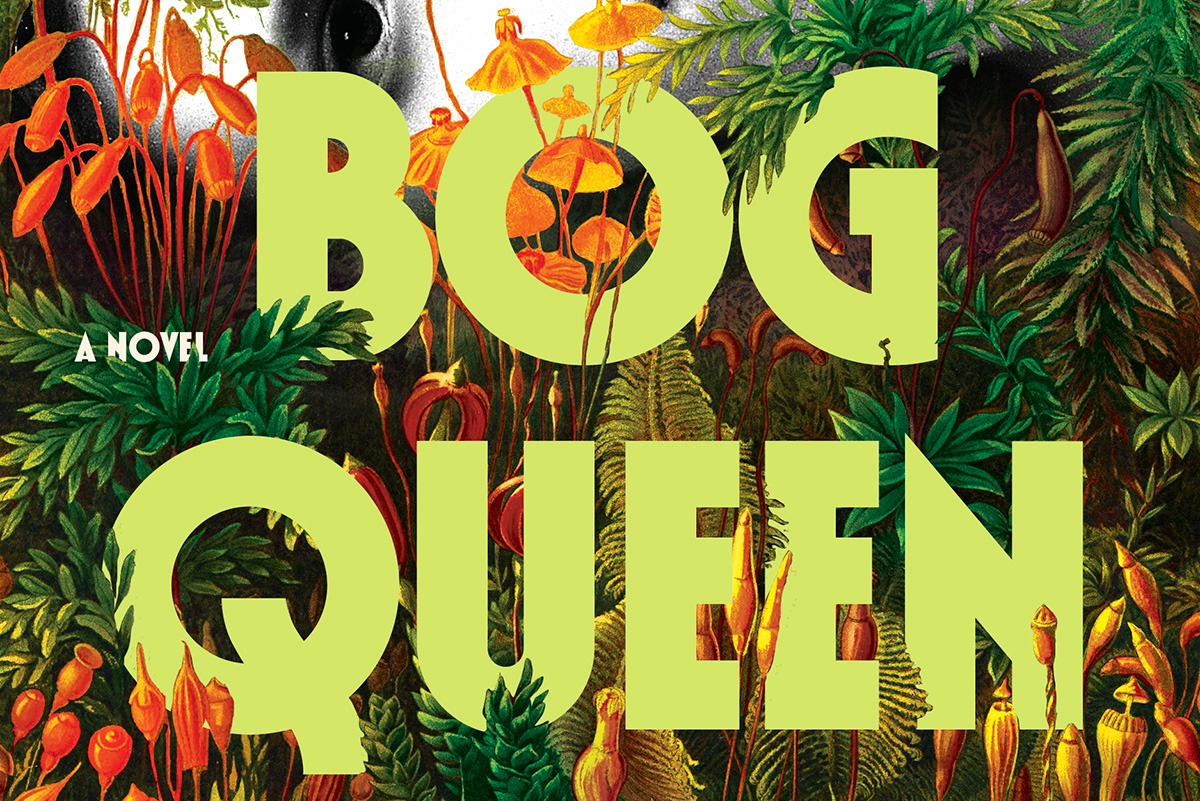
‘Bog Queen’
By Anna North
c.2025, Bloomsbury
$28.99/288 pages
Consider: lost and found.
The first one is miserable – whatever you need or want is gone, maybe for good. The second one can be joyful, a celebration of great relief and a reminder to look in the same spot next time you need that which you first lost. Loss hurts. But as in the new novel, “Bog Queen” by Anna North, discovery isn’t always without pain.

He’d always stuck to the story.
In 1961, or so he claimed, Isabel Navarro argued with her husband, as they had many times. At one point, she stalked out. Done. Gone, but there was always doubt – and now it seemed he’d been lying for decades: when peat cutters discovered the body of a young woman near his home in northwest England, Navarro finally admitted that he’d killed Isabel and dumped her corpse into a bog.
Officials prepared to charge him.
But again, that doubt. The body, as forensic anthropologist Agnes Lundstrom discovered rather quickly, was not that of Isabel. This bog woman had nearly healed wounds and her head showed old skull fractures. Her skin glowed yellow from decaying moss that her body had steeped in. No, the corpse in the bog was not from a half-century ago.
She was roughly 2,000 years old.
But who was the woman from the bog? Knowing more about her would’ve been a nice distraction for Agnes; she’d left America to move to England, left her father and a man she might have loved once, with the hope that her life could be different. She disliked solitude but she felt awkward around people, including the environmental activists, politicians, and others surrounding the discovery of the Iron Age corpse.
Was the woman beloved? Agnes could tell that she’d obviously been well cared-for, and relatively healthy despite the injuries she’d sustained. If there were any artifacts left in the bog, Agnes would have the answers she wanted. If only Isabel’s family, the activists, and authorities could come together and grant her more time.
Fortunately, that’s what you get inside “Bog Queen”: time, spanning from the Iron Age and the story of a young, inexperienced druid who’s hoping to forge ties with a southern kingdom; to 2018, the year in which the modern portion of this book is set.
Yes, you get both.
Yes, you’ll devour them.
Taking parts of a true story, author Anna North spins a wonderful tale of druids, vengeful warriors, scheming kings, and a scientist who’s as much of a genius as she is a nerd. The tale of the two women swings back and forth between chapters and eras, mixed with female strength and twenty-first century concerns. Even better, these perfectly mixed parts are occasionally joined by a third entity that adds a delicious note of darkness, as if whatever happens can be erased in a moment.
Nah, don’t even think about resisting.
If you’re a fan of feminist fiction, science, or novels featuring kings, druids, and Celtic history, don’t wait. “Bog Queen” is your book. Look. You’ll be glad you found it.
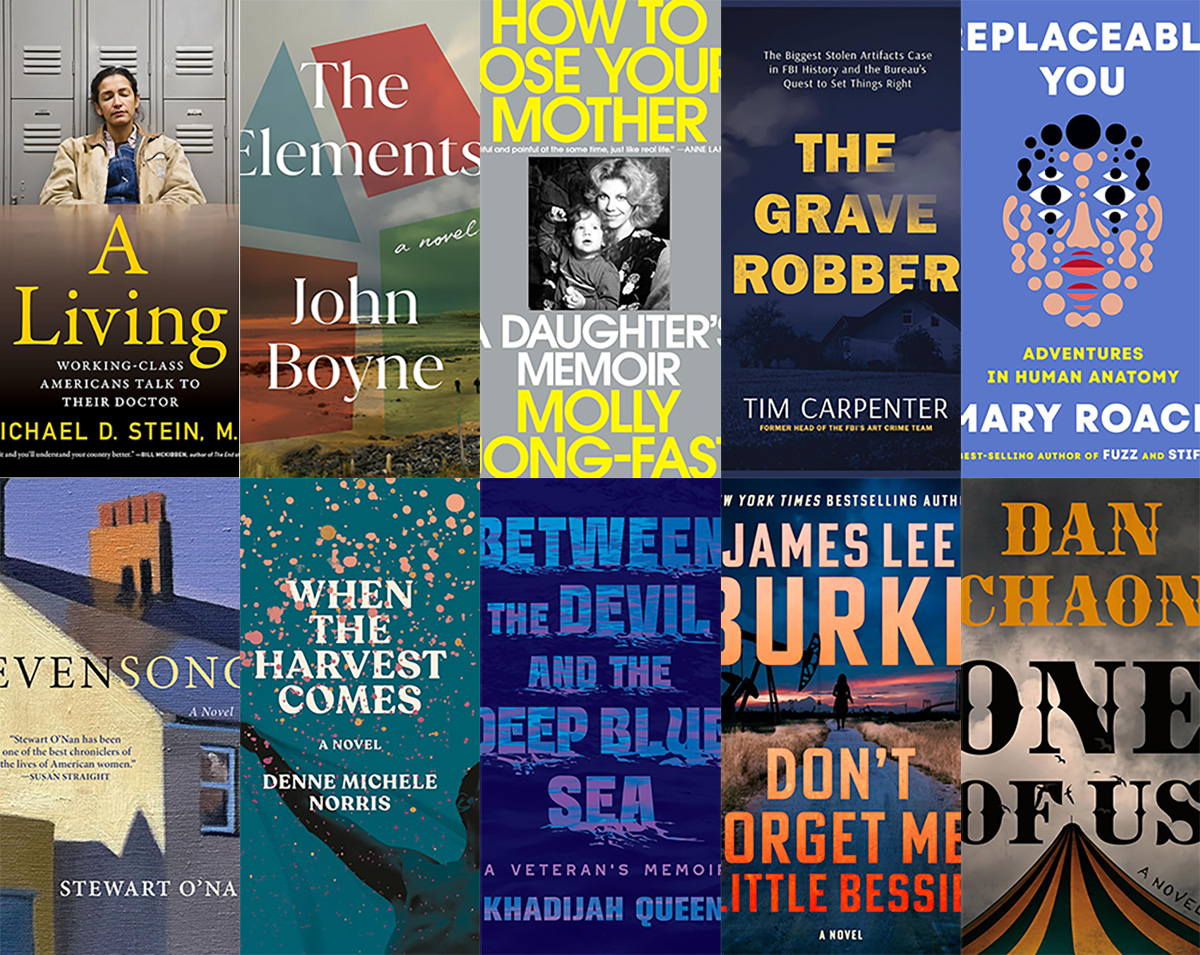
This past year, you’ve often had to make do.
Saving money here, resources there, being inventive and innovative. It’s a talent you’ve honed, but isn’t it time to have the best? Yep, so grab these Ten Best of 2025 books for your new year pleasures.
Nonfiction
Health care is on everyone’s mind now, and “A Living: Working-Class Americans Talk to Their Doctor” by Michael D. Stein, M.D. (Melville House, $26.99) lets you peek into health care from the point of view of a doctor who treats “front-line workers” and those who experience poverty and homelessness. It’s shocking, an eye-opening book, a skinny, quick-to-read one that needs to be read now.
If you’ve been doing eldercare or caring for any loved one, then “How to Lose Your Mother: A Daughter’s Memoir” by Molly Jong-Fast (Viking, $28) needs to be in your plans for the coming year. It’s a memoir, but also a biography of Jong-Fast’s mother, Erica Jong, and the story of love, illness, and living through the chaos of serious disease with humor and grace. You’ll like this book especially if you were a fan of the author’s late mother.
Another memoir you can’t miss this year is “Between the Devil and the Deep Blue Sea: A Veteran’s Memoir” by Khadijah Queen (Legacy Lit, $30.00). It’s the story of one woman’s determination to get out of poverty and get an education, and to keep her head above water while she goes below water by joining the U.S. Navy. This is a story that will keep you glued to your seat, all the way through.
Self-improvement is something you might think about tackling in the new year, and “Replaceable You: Adventures in Human Anatomy” by Mary Roach (W.W. Norton & Company, $28.99) is a lighthearted – yet real and informative – look at the things inside and outside your body that can be replaced or changed. New nose job? Transplant, new dental work? Learn how you can become the Bionic Person in real life, and laugh while you’re doing it.
The science lover inside you will want to read “The Grave Robber: The Biggest Stolen Artifacts Case in FBI History and the Bureau’s Quest to Set Things Right” by Tim Carpenter (Harper Horizon, $29.99). A history lover will also want it, as will anyone with a craving for true crime, memoir, FBI procedural books, and travel books. It’s the story of a man who spent his life stealing objects from graves around the world, and an FBI agent’s obsession with securing the objects and returning them. It’s a fascinating read, with just a little bit of gruesome thrown in for fun.
Fiction
Speaking of a little bit of scariness, “Don’t Forget Me, Little Bessie” by James Lee Burke (Atlantic Monthly Press, $28) is the story of a girl named Bessie and her involvement with a cloven-hooved being who dogs her all her life. Set in still-wild south Texas, it’s a little bit western, part paranormal, and completely full of enjoyment.
“Evensong” by Stewart O’Nan (Atlantic Monthly Press, $28) is a layered novel of women’s friendships as they age together and support one another. The characters are warm and funny, there are a few times when your heart will sit in your throat, and you won’t be sorry you read it. It’s just plain irresistible.
If you need a dark tale for what’s left of a dark winter season, then “One of Us” by Dan Chaon (Henry Holt, $28), it it. It’s the story of twins who become orphaned when their Mama dies, ending up with a man who owns a traveling freak show, and who promises to care for them. But they can’t ever forget that a nefarious con man is looking for them; those kids can talk to one another without saying a word, and he’s going to make lots of money off them. This is a sharp, clever novel that fans of the “circus” genre shouldn’t miss.
“When the Harvest Comes” by Denne Michele Norris (Random House, $28) is a wonderful romance, a boy-meets-boy with a little spice and a lot of strife. Davis loves Everett but as their wedding day draws near, doubts begin to creep in. There’s homophobia on both sides of their families, and no small amount of racism. Beware that there’s some light explicitness in this book, but if you love a good love story, you’ll love this.
Another layered tale you’ll enjoy is “The Elements” by John Boyne (Henry Holt, $29.99), a twisty bunch of short stories that connect in a series of arcs that begin on an island near Dublin. It’s about love, death, revenge, and horror, a little like The Twilight Zone, but without the paranormal. You won’t want to put down, so be warned.
If you need more ideas, head to your local library or bookstore and ask the staff there for their favorite reads of 2025. They’ll fill your book bag and your new year with goodness.
Season’s readings!
The Blade may receive commissions from qualifying purchases made via this post.

